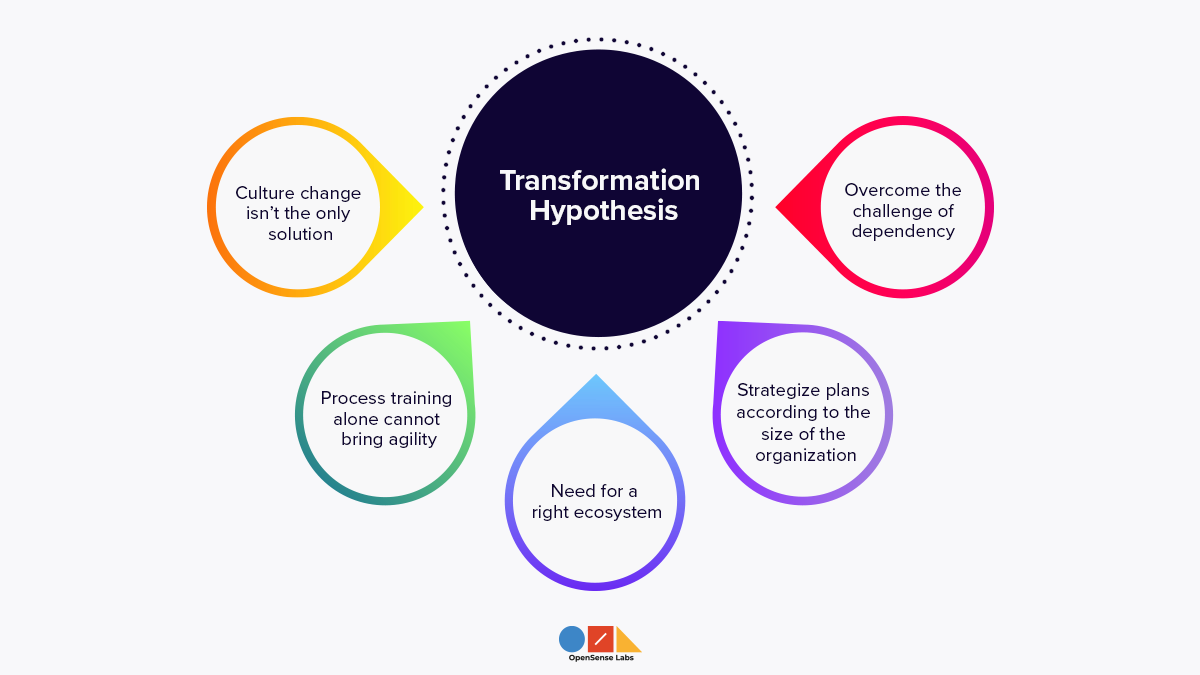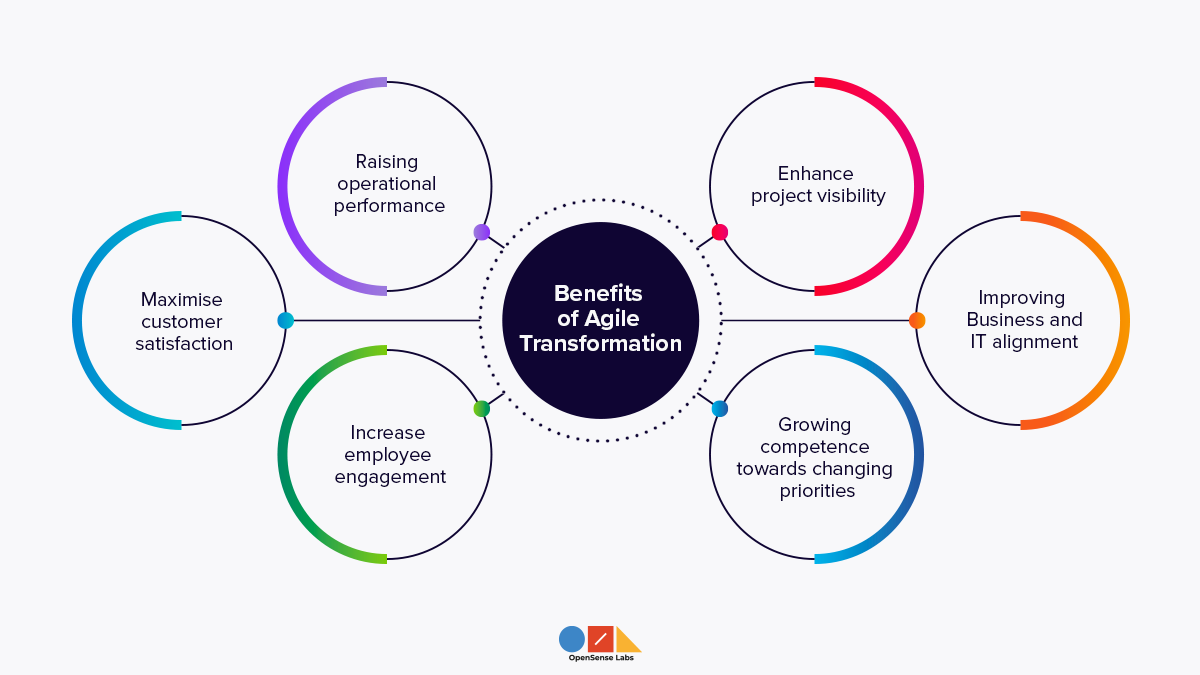Enterprise agility is one of the most commonly adopted transformation approaches which comes up along with a lot of challenges. The companies need to reshape the organizational structures, make changes in the operational models and reform the old ways of working techniques. The agile transformation includes a big shift in organizational culture and that makes an organization ponder over it or even neglect it. But eventually, organizations realize the importance of it, apply agile transformation techniques, and receive immense benefits that help them evolve and move closer towards their goals and aspirations. This article will guide you through the right approach needed towards adopting the agile transformation in your organization.
To successfully adopt an agile transformation, you need a plan
To succeed with the agile transformation, you need to clearly understand the fact that why are you making such time and effort to adopt this transformation and what exactly you want to gain from it. It is important to have clarity upon what changes you will have to make so that the desired outcomes can be achieved by your business. For this let’s firstly, understand the importance of preparing a proper business case for adopting agile transformation at your organization. It is important to convince the decision-makers to realize the significance of approaching agility in the work culture with the right business case. Before that, go through what agile development methodology actually means.
Making business case for agile transformation
A business case explains the main objectives of the organization in regards to agile transformation. Generally, adopting agile leads to desired business outcomes but only if it is approached in the right manner. Therefore, it is essential to have some set important goals which will help in the overall growth of the company with agility. Here is an insight into the recommended goals.

The first and foremost goal is to meet customer commitments on time. It helps in building trust between customers and the company leading to customer satisfaction. Secondly, it is essential to maintain high-quality products and services as at times companies fail to deliver suitable services as promised to the customers. This further helps in building a good brand reputation for the company. Thirdly, one of the aims of adopting agility in an enterprise is to efficiently reduce their costs and maximize profits. Lastly, the companies expect an early return on investment with agility as by practicing traditional working methods they struggle with long delivery cycles which do not allow them to receive early return on investment. Read this complete guide on agile transformation to know more.
Now, we will get an overview of the transformation hypothesis to help us approach agility in the right way.
A step closer to agility with Transformation Hypothesis
A Transformation Hypothesis describes the real purpose behind choosing agile transformation. Along with accepting agility, companies have to be flexible enough to embrace change in various working techniques. But sometimes it might not sound comfortable for the employees as they are accustomed to working with the same old traditional techniques. So, in situations where employees aren’t confident enough and are faced with certain challenges, the companies should proactively help them to overcome such difficulties and welcome change. Below are some of the concerns which need to be resolved to strongly practice agility in your organization.

Culture change isn’t the only solution
It is observed that adopting agility brings a big shift in the work culture of an organization, so we assume that the culture change alone will look after all the necessary steps and efforts required to successfully implement such a transformation within the company. But in reality, it isn’t so. There is also a need for proper guidance in forming cross-functional teams which have various functional expertise to increase innovation in products and services. To succeed with agility, the company will have to look upon various factors, apart from considering culture as the only means to improve agility.
Process training alone cannot bring agility
We get to see that employees are given training from coaches to learn new methods and techniques, also expecting them to be capable enough to face any challenges which they witness while practicing agility. But the problem here is, it is nearly impossible to handle technical, governance, and organizational issues by employees with the process education obtained during the training sessions. Such issues need to be resolved by providing essential support to the company employees to tackle such hard situations.
Need for a right ecosystem
To reach the desired level of agility, there is a need for an ecosystem that facilitates continuous improvement to achieve a company’s agility goals and objectives. If a company fails to build the right ecosystem, it will be challenging to sustain agility in an organization for better adaptability and resilience.
Strategize plans according to the size of the organization
One has to strategize plans depending on the size of the organization to sustain agility. For example, the strategy which you will use for transforming a single team will certainly differ from the strategy you plan for a large-sized company having 500 or more employees. In the same manner, if you are leading a group of five to seven people, sending them to training sessions might be sufficient. But if you lead 1000 employees, the planning and arrangement must be executed on a much different level. So, it justifies the fact that the size of the organization is to be considered while adopting agility.
Overcome the challenge of dependency
Dependencies can bring hurdles in successfully attaining agility in organizations. When we have small teams, it is easier to manage dependencies but if we have multiple teams working towards the same goal, it becomes very difficult to handle inter-team communication and collaboration. So, removing dependencies shall be one of the primary tasks. For smooth delivery of products and services, it is very essential to strategize plans to overcome dependencies and develop agility in an organization.
Benefits achieved by adopting agile transformation
Many organizations have received benefits from practicing agile transformation in recent years. They need to put the right agile transformation approach to attain the desired business outcomes with this transformation. The agility in enterprises allows flexibility to adapt new organizational practices and techniques leading to maximization of business value.
Moving forward, we will discuss some of the benefits which are attained by companies adopting agile transformation in their business.

Maximise customer satisfaction
With agility, companies mainly focus on adding value to the customer experience by understanding their requirements and making early delivery of products and services. It helps in evolving customer satisfaction by prioritizing customer feedback to improve the product quality as per their expectations. Enterprise agility allows employees to provide services with expertise, proper collaboration among various teams, and transparency which leads to an increase in customer satisfaction.
Here is an example of Asia Pacific Telco, which adopted an agile operating model to meet customer needs and was successful in increasing customer satisfaction by implementing new ideas and techniques into their work process. Below is the diagram showing the transformation shift towards a positive direction leading to a great customer experience.
Increase employee engagement
Adopting agility facilitates employees the ability to use their creativity to produce better work performance and results. It gives them a sense of ownership to take all the necessary decisions to improve their work productivity and help them feel valued in the workplace. Such flexibility helps in increasing employee engagement to a great extent also empowering companies to reach their desired goals and ambitions. For instance, read how you can build a diverse and inclusive team by leveraging agile techniques.
Raising operational performance
Agility helps in providing various business models to the organizations which further helps in improving the operational performance according to the desired expectations. Due to this agile transformation, the companies are availed with various approaches which help in increasing the speed of company decision making and product development. The target achievement rate can be seen improving remarkably, by the agile companies which prove to be one of the major achievements of a progressing enterprise.
Growing competence towards changing priorities
With agility, a behavioral transformation takes place among the employees to reach their highest potential in embracing change and innovation. They learn to handle the changing priorities within the organization in the form of resources re-location to a team who needs support and assistance to survive the challenges which come along with agility. They get comfortable with the changes that take place in their work process and techniques, accepting change for better company growth.
Enhance project visibility
Project visibility provides a clear vision of a project performance which includes allocating resources, potential risks, and proper distribution of responsibilities. Increased visibility ensures everyone involved in the project understands the objective of the project and their role in meeting the business goals and aspirations. It gives clarity to stakeholders regarding the real-time status of the project. Agility helps in changing any project plan or initiative following customer or stakeholder needs and requirements for better project performance. For instance, read how imbibing agile documentation processes helps improve project management.
Improving Business and IT alignment
Business IT alignment can be regarded as a business strategy that helps in achieving the business objectives leading to improved financial performance. This alignment is necessary to adapt to the constant change in the company and environment due to agility. Therefore, both business agility and business-IT alignment should go hand in hand to maintain company growth and development. For instance, read how the inclusion of agile processes to the testing phases of software development can be immensely beneficial.
Lastly, the most important benefit which we witnessed recently by adopting the agile transformation is the flexibility of working at our convenience during the pandemic of COVID 19. Due to this pandemic, the organizations felt the need for agile transformation rather than sticking to the old traditional transformation techniques which created hurdles in the proper functioning of their business. According to McKinsey’s research with Harvard Business School during COVID-19, agile companies have received better results in comparison to non-agile companies.
Companies sharing their successful journeys with agile transformation
With agility, many organizations have achieved immense success leading their business towards their set goals. Here are some of the companies sharing their success stories which can act as a motivation for everyone to move towards agile transformation.
Ericsson
Ericsson aimed at improving the delivery of products within the stipulated time leading to an increase in customer satisfaction. To achieve this target, they adopted agility in 2008. They implemented cross-functional teams which could focus on specific projects along with building effective communication across several teams. Instead of individual targets, each team worked towards both organizational and group goals to receive desired results. After making such changes with the help of agile transformation, Ericsson could successfully achieve speedy development, faster customer feedback, and generate higher revenue according to desired company standards.
Bank of America
In late 2012, the agile transformation in global markets at Bank of America began. Merrill Lynch, the director of global markets technology at the Bank of America expressed that their main aim was to improve the time to deliver better company solutions and also reduce key person dependencies across his technology team. They adopted Scrum (a specific Agile methodology) also providing an environment to the employees where they could experiment by taking risks to bring exceptional work results. The cross-functional team formation too was encouraged to turn business ideas into working products for achieving company targets. After a year of consistent efforts, they finally succeeded in meeting their business goals with agility.
LEGO
LEGO attained success by adopting agile transformation in early 2018. They adopted this approach in their two large digital departments. After such adoption, they witnessed various improvements in several areas like market engagement, digitalization, and reduction in project delivery time. This further brought a sense of motivation and satisfaction among the employees. So, with this transformation, LEGO could set a successful journey of embracing change.
To get more insight on a company's smooth agile transformation, you can go through this book- “Agile Transformation: A Brief Story of How an Entertainment Company Developed New Capabilities and Unlocked Business Agility to Thrive in an Era of Rapid Change” which will give you an idea about a company in the entertainment industry who got excellent results by adopting agility in its work culture. This will be a good read.
Here is a video presented by Scrum Alliance about IBM’s wonderful experience of learning, implementing, and overcoming challenges with agile transformation. Without any further wait, take a look at their exciting agile transformation journey.
Final thoughts
Agility is an approach to drive performance and provide endless innovation to organizations. Adopting this transformation can break the old traditional working methods enabling to achieve tremendous growth and advancement in business. So, the organizations will have to step out of their comfort and strive for something new which can deliver exceptional business outcomes.
Subscribe
Related Blogs
Trek n Tech Annual Retreat 2025: A 7-Day Workcation of OSL

OSL family came together for the Trek n Tech Annual Retreat 2025, a 7-day workcation set amidst the serene beauty of…
Exploring Drupal's Single Directory Components: A Game-Changer for Developers

Web development thrives on efficiency and organisation, and Drupal, our favourite CMS, is here to amp that up with its…
7 Quick Steps to Create API Documentation Using Postman

If you work with API , you are likely already familiar with Postman, the beloved REST Client trusted by countless…




